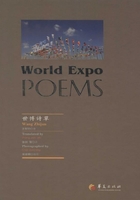
Preface (Ⅱ)
The World Expo held in Shanghai has many shining points, one of which is the fact that, for the first time in the World Expo’s history of 159 years, a pavilion for the disabled is built and displayed.
Since the opening of this World Expo, the Life and Sunshine Pavilion has become an important part of Theme Pavilions cluster. Visitors include President Hu Jingtao and countless friends from foreign lands, and of even greater number are our own countrymen of all ages and of both sexes. The theme of “Cherishing Life and Sharing Sunshine” is recognized by many and spread among even more people. A great many visitors have stopped to visit the pavilion and have been greatly moved by the time they leave.
These dramatic episodes and scenes have been witnessed and recorded by one man whose name is Mr. Wang Zhijun, who observes, thinks, sings, and quietly chews and fathoms the significance of each of them, writing down poem after poem about them. Only five months after the opening of the Expo, he has already had three hundred and seventy-eight poems in traditional Chinese poetic style.
Why did he have so many ideas? Why did he have so many poetic feelings? Why was he not able to stop, but kept writing, almost as if in a sitting, so many poems which come togther to form this World Expo Poems?
The reason is simple. He has a lot of affection for the World Expo.
Since he came to Shanghai to live and work with Shanghai Disabled Persons’ Association and with staff of the Life and Sunshine Pavilion, he cultivated deep feelings for the pavilion, for every inch of it congealed his work and sweat. He knew all the hard work that went into the building of the pavilion, its growth from small to big, from a framework to an iluuminating and imposing construction. So he took up his pen and wrote about the staff of the Life and Sunshine Pavilion. The selfless volunteers first of all came into his sight and he praised them: “They are like China’s national treasure, / The Jade-Carved Cabbage, shining with virtues.” And he wrote of the migrant workers who conscientiously built the pavilions of the Expo with their hands and sweats: “Rural migrant workers from five lakes and four seas / Worked a miracle, in the construction of the Expo.” And his remark becomes lively and compassionate when he wrote of the famously handless Shanghai calligrapher Wu Jieping: “Pity is Jieping who has lost his hands, yet / He writes dexterously as if inspired by God.” After that, he wrote about the landscapes of the World Expo Park and this is the World Expo Axis under his pen: “Wind summons, cloud covers, and rain comes, / There’re too many beautiful scenes for eye to catch.” And the most remarkable lines are on the World Expo Cultural Center: “Like a beautiful jade fallen from heaven, or / A flying saucer twirling on the ground, it stands.”
We can say that the scenes, objects and peoples in the World Expo Park are all touched and transformed one by one by his miraculous pen. As he himself says to me, “Writing so much down on paper, I have not thought of in the first place”. As is said in the classics, if moved in the recess of the heart, feelings and emotions there will reach.
I think this is exactly what the ancients often said about “poetry expresses heart”. As we all know, when the Shanghai World Expo closes, most of the pavilions will be demolished or moved elsewhere. What we see this year in the Park will mostly be gone by the same time next year. Like many of the pictures and documentaries recorded by cameras and camcorders, the more than three hundred poems bound within the covers of World Expo Poems will retain many tender and beautiful memories of ours and arouse endless imaginative thinking.
This will function as a foreword.
Author Ye Xin
In Shanghai, 2010